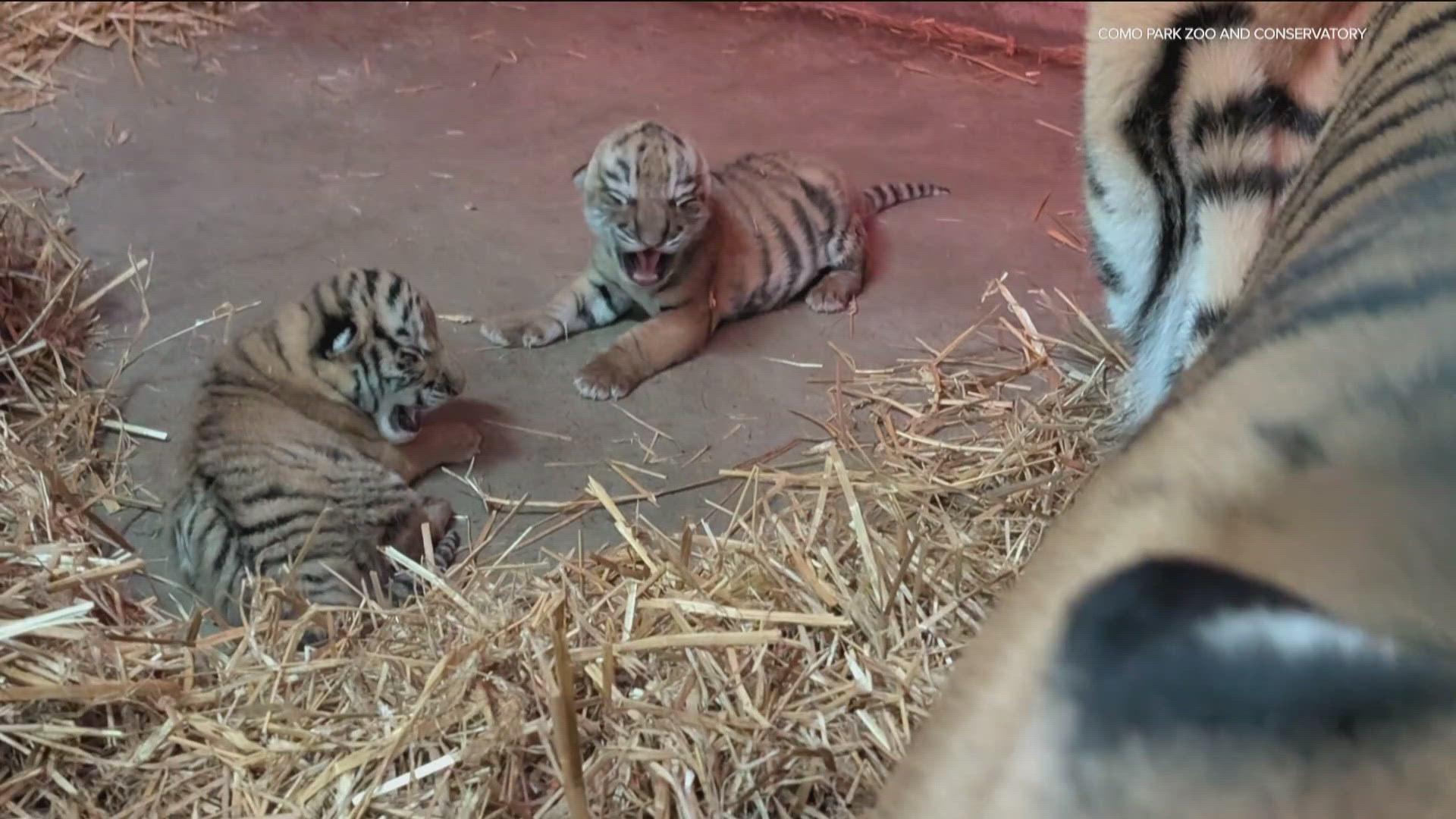APPLE VALLEY, Minn. — A pair of rare Amur tiger cubs are making their public debut at the Minnesota Zoo, raising hopes for preserving an endangered species that's native to far eastern Russia and northern China.
Andrei and Amaliya got to venture outside and feel the grass of their new home under their paws Wednesday for the first time since their 12-year-old mother, Dari, gave birth on May 23.
“They’ve done quite well since then," zoologist Trista Fischer said. "We’ve monitored them very closely. Dari’s been fantastic. She’s provided outstanding maternal care. And so today we’ve reached the point where they’re fully vaccinated and they’re now about 40 to 45 pounds (18-20 kilograms).”
Scientists estimate the Amur tiger population is just around 400 to 500 in the wild. They were near the brink of extinction in the 1930s and 1940s but have recovered somewhat since then. It's tricky to breed them, and around one in four Amur cubs don't make it to adulthood, whether it's in the wild or in captivity, she said. Poachers are another major threat.
But the Minnesota Zoo, located in Apple Valley, has a long history of conserving tigers. Its Amur tigers have produced 57 cubs, 46 of which survived for at least 30 days. Of those 46, 21 have gone on to produce litters of their own, amounting to another 86 cubs. The births of Andrei and Amaliya raised the zoo's population to seven Amur tigers, including their sire, Luka.
Fischer is the leading coordinator for the Tiger Species Survival Plan, a breeding program in the United States with facilities in other countries that work on a global level to preserve the big cats. The plan manages three groups of tigers: Sumatran, Malayan and Amur.
“This litter is so valuable to the population right now,” she explained, saying the genetic diversity of healthy tigers in human care could someday be used to help support populations in the wild.
Zoo spokesperson Zach Nugent said the cubs will remain housed together with their mom for about 18 months, before Andrei, the male, is moved to separate housing, which is around the same time a male cub in the wild would start venturing out on his own. Amaliya, the female, may spend a little more time with Dari, up to 24 months. Then Fischer will determine whether either cub should be bred, and potentially moved for that to another accredited zoo, which typically happens after the cubs are 2 years old.
“Aww, I love when they get their little Yoda ears,” Fischer said referring to the pointy ears of the Star Wars character as she watched Amaliya and Andrei explore the new terrain of their enclosure. She said it was an emotional, exciting and proud moment for her and her team.
“Our work’s not over, but all that work so far is really paying off in how well that these cubs are acclimating to a new surrounding, pretty much immediately," she said as the little tigers roamed outside with their mother. "They’re showing a lot of resiliency, which is something that we work hard for in human care. We want these animals to have a lot of confidence and be able to adapt to new environments just as they’re doing today.”
The cubs will still return to their maternity den for sleep, and Dari decides when that happens each day. During the zoo's welcome event, Dari was seen leading them out of sight after about 90 minutes of active play.
"If you want to see them at the tiniest they are for public debut, we would encourage people to come about 9, 10 a.m.," Fischer said. "That's when they're very active."
In about 2 weeks, their mom will keep them out for about half a day. Then, about a month from now, she will likely be comfortable staying out all day with the cubs. The Minnesota Zoo closes at 4 p.m. daily in the fall.
If you miss the cubs, you'll likely still catch Dari's three 2-year-old tigers in the den. Brosno and Vostok are males and Yana is female. They were her 3rd litter. Her newest babies mark the 4th.
"She did have the same sire for the past few litters but now she's got a new man," Fischer said, referring to Luka. "So, part of the breeding program is we look at the sustainability of the population into 100 years, and in order for us to do that, we have to make a lot of genetic matches and we want that population to be as diverse as possible. So, should we need to reintroduce into the wild, we have the healthiest population available to do."
Fischer went on to say Dari seems to get more confident with each birth.
There are now seven total Amur tigers at the Minnesota Zoo. Meanwhile, Como Zoo in St. Paul also just got more Amur tigers with the birth of two cubs on Aug. 29. They're the first to be born at that zoo in more than 40 years.
"They are endangered, so every birth is really important to the population," Fischer said.

